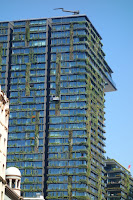 |
| Michele in her kitchen. (©Reuters) |
Yesterday, in a kitchen in Washington D.C.:
- Michele: “Drinking recycled water? What do you mean, my Dear?!”
- Barack: “Well, in several places around the world, they purify sewage water and then drink it. The water is safe and good. You know, we will need more of that in the future!...”
A BLOCK OF GREEN BUILDINGS
 |
| There is greenery everywhere on the facades of the tower. These guys are not cleaning the windows, they are gardeners! |

The tower hosts the biggest recycled water facility in the world built in the basement of a residential building. We had the chance to visit the plant together with its best guide, Andrew! Andrew Horton is the Plant Operations Manager. He explains: “In this tower, we collect the apartment wastewater - bathrooms, kitchens, toilets and laundries - we purify it and send the recycled water back to the apartments! The building has two separated water networks: one for the traditional drinkable water supplied by the City of Sydney, and one for our recycled water."
THE PURPLE PIPE
 |
| Andrew and Frédéric. |
Of course the purification process includes several strong treatments. One of them is microscopic membrane fibres, which “remove bacteria, pathogens and viruses from the water.” A very sophisticated filter blocking very small things! Andrew adds: “Other robust processes are the ultraviolet and the chlorine treatments. At the end of it, the water goes out from the plant in one huge purple pipe. Purple is the official color for recycled water!
We do not drink the recycled water here, although we could. After all these purification processes, the water is as pure as spring water, if not more so!” says Andrew. At Central Park, the recycled water is going back to the apartment toilet flushing, washing machines and garden watering; it is not drunk.
THEY’VE STARTED TO DRINK IT
 |
| Stuart and Carolina, in Stuart's lab! |
 |
| University of New South Wales, Sydney. |
We wanted to know more about recycled water around the world, so we went to the University of New South Wales and met Stuart Khan. Stuart was recently appointed to the Water Quality and Health Technical Advisory Group of the UN’s World Health Organization. He mainly works on how hazards and weather events put water supply at risk; he also knows a lot about recycling water. “In Australia we do not drink recycled water yet. There are two main reasons for that,” says Stuart. “The two reasons are linked actually. We do not drink it first because of regulations and secondly because of public acceptance. Australian regulations still do not authorize it; there are political interests behind the issue and people are not ready yet.”
Drinking recycled wastewater may be hard to swallow, literally! In 2006 the citizens of Toowoomba, eastern Australia, rejected the idea through a referendum. However there are more and more stresses on water supplies. On the one hand population is growing. On the other hand, “global warming increases the severity of extreme weather events” says Stuart. “How to protect our water supply from events related to climate change? It is an issue I work on every day. Recycling water is part of the solution for securing drinkable water.”
 |
| At the City Gallery of Singapore we could find explanations about how the city recycles water. |
Many cities are already incorporating recycled wastewater into the drinking water supply. It is the case in Singapore, the UK, the US and Belgium. Like at Central Park wastewater is purified to the highest standards. Not only is recycling becoming an option, the sustainable city will require it.
~~~
In a 2012 article, we talked about Sydney working on a network of trigeneration plants. Well, there is a trigeneration facility in operation at Central Park! It is located in the middle of the block, inside an old brewery building. The station provides heat and chill water to the buildings around.
~~~
"Extreme weather events include heavy rainfall and floods, cyclones,
droughts, heatwaves, extreme cold, and wildfires. Each of these types of events can potentially impact drinking water quality by acting water catchments, storage reservoirs, the performance of water treatment processes or the integrity of distribution systems."
Extract from a study by Stuart among others.
droughts, heatwaves, extreme cold, and wildfires. Each of these types of events can potentially impact drinking water quality by acting water catchments, storage reservoirs, the performance of water treatment processes or the integrity of distribution systems."
Extract from a study by Stuart among others.
~~~~~~~~~~~~~~~~~~~~~~~~~~~~~~~~~~~~~~~~~~~~~~~~~






No comments:
Post a Comment